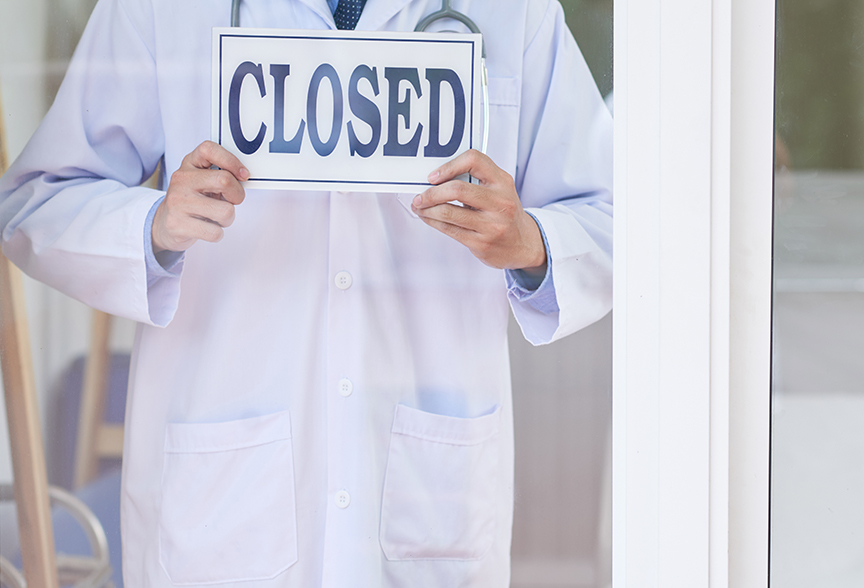Hospital, health system, and independent laboratories and anatomic pathology groups should anticipate continued decrease in outpatient testing volumes, but that decline may be offset with telemedicine-ordered tests.
More than 1.4 million jobs in the healthcare industry were lost in April, according to statistics provided by the U.S. Bureau of Labor Statistics. Over 80% of these lost jobs were in outpatient settings such as private practice doctors, dentists, and chiropractors. Physician offices have seen a drop in payrolls of $300,000 on average—over a 10% decrease. Dental offices have been particularly hard hit, with a drop in payrolls of over 50%.
Headlines urging people to stay home for non-emergent care, such as with The Washington Post’s “Fearful doctors and nurses at walk-in clinics have a message for patients: Stay away”, coupled with government stay-at-home orders have led to these reduced volumes of outpatient visits.
In Missouri, Mercy Hospital St. Louis announced layoffs and furloughs at every level as a result of financial losses, according to the St. Louis Post Dispatch. The hospital notes on its website 218 clinic and outpatient locations and some 671 physicians. The Springfield Business Journal recently updated the situation to nearly 700 cuts and furloughs.
Halee Fischer-Wright, MD, MMM, FAAP, FACMPE, President and CEO of the Medical Group Management Association (MGMA), was quoted as saying, “Physician practices are seeing declines in patient volume of 30 percent to 75 percent.”

“This is a finite period of time, and we don’t know what’s on the other end,” says Medical Group Management Association (MGMA) President and CEO Halee Fischer-Wright, MD, MMM, FAAP, FACMPE. (Photo source: MGMA)
While outpatient visits have significantly declined in recent months, Fischer-Wright viewed telehealth as a new factor that has helped to alleviate some of the financial pressure on outpatient practices. “Since CMS changed their regulation of reimbursement, we’ve seen telehealth enthusiastically embraced across the country, to the point where it has become an integral part of care delivery,” stated Fischer-Wright for Medical Economics.
It is unclear what the long-term effects of the growth in telemedicine will be once the pressures of the pandemic have abated. There are indications that telehealth may become more widely accepted and used.
However, for physician office practices, one drawback of telemedicine may be that reimbursement is significantly less than an office visit, Dr. Cortney Linville told Main Public. Also, patients may be more inclined to skip or miss visits. Linville’s primary care practice lost nearly half of its business in March and April, and the practice has been forced to reduce staff.
Staff reductions and financial hits resulting from COVID-19 precautions are part of a growing and concerning pattern throughout Pennsylvania as well. The Philadelphia Tribune reports private medical practices are suffering from the coronavirus’s many complications. In recent surveys there by Rockpointe in collaboration with the Pennsylvania Medical Society, physicians and practice administrators reported reductions of at least half their clerical staff (26% of respondents), nursing staff (21%,) nurse practitioner/physician’s assistant staff (18%), and physicians (12%), according to the Tribune.
Implications for Clinical Laboratories
Outpatient healthcare providers have continued to see decreased volumes as stay-at-home orders and guidelines stretch into their third month in many states. Job cuts within the healthcare sector indicate that stay-at-home orders significantly influence patients and reduce their willingness to resume routine healthcare visits.
While outpatient clinical laboratory testing orders are starting to increase, labs should continue to expect decreased volumes overall, depending on the level of stay-at-home guidelines in their specific localities.
Another potential implication for clinical laboratories is that reduced staffing among outpatient providers may make it more difficult for these practices to resume their normal operations. Normal operations would require pre-COVID-19 staffing levels, and staff that have been laid off or furloughed may no longer be available, creating a barrier to resuming pre-pandemic operations. This may prolong the decreased testing volumes that have affected clinical laboratories.
As outpatient volumes have fallen, practices may see these reductions become long term due to patients not coming back to their practices. Changes in the financial situation of patients, along with the increased use of telehealth and continued fear of contracting COVID-19, will only add to continued reductions in patient volumes.
The good news is that more telemedicine episodes will increase the need for laboratory diagnostic tests to aid physicians in their work. Clinical laboratories and anatomic pathology groups should consider the additional revenue that they could obtain from performing telemedicine-ordered testing and should position themselves to capture the additional testing volume that will be created from this new source.
How should clinical laboratories respond to this growing expansion of virtual care? Experts advise lab leaders to reach out to health plans soon and determine their inclusion in virtual healthcare networks. Labs also may benefit by making test scheduling and reporting accessible and convenient to insurance company members and consumers choosing telehealth.

—By Caleb Williams, Editor, COVID-19 STAT
Related Resources:
Physician practices reeling from COVID-19 financial losses
Update from Bureau of Labor Statistics
Coronavirus is obliterating outpatient care
Mercy reports nearly 700 cuts, furloughs
Maine’s Independent Physicians Saw Steep Revenue Declines When Offices Shut Down
Survey and Report: Assessing the Impact of COVID-19 on Outpatient Care in Pennsylvania
Private medical practices suffer from the coronavirus’s many complications
‘There is hope’: MGMA’s Fischer-Wright provides leadership perspective on COVID-19 crisis






